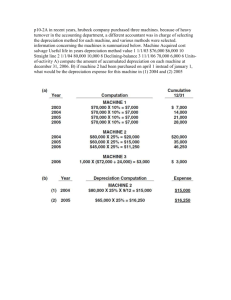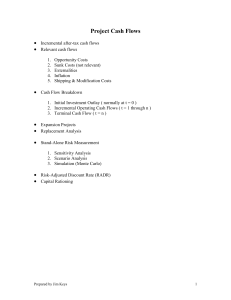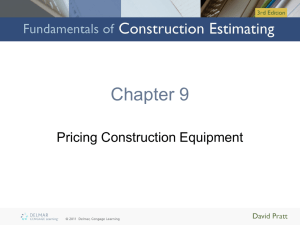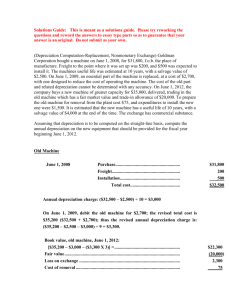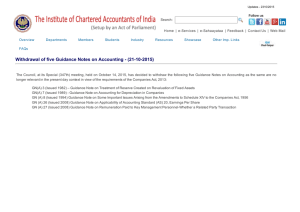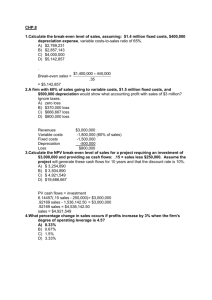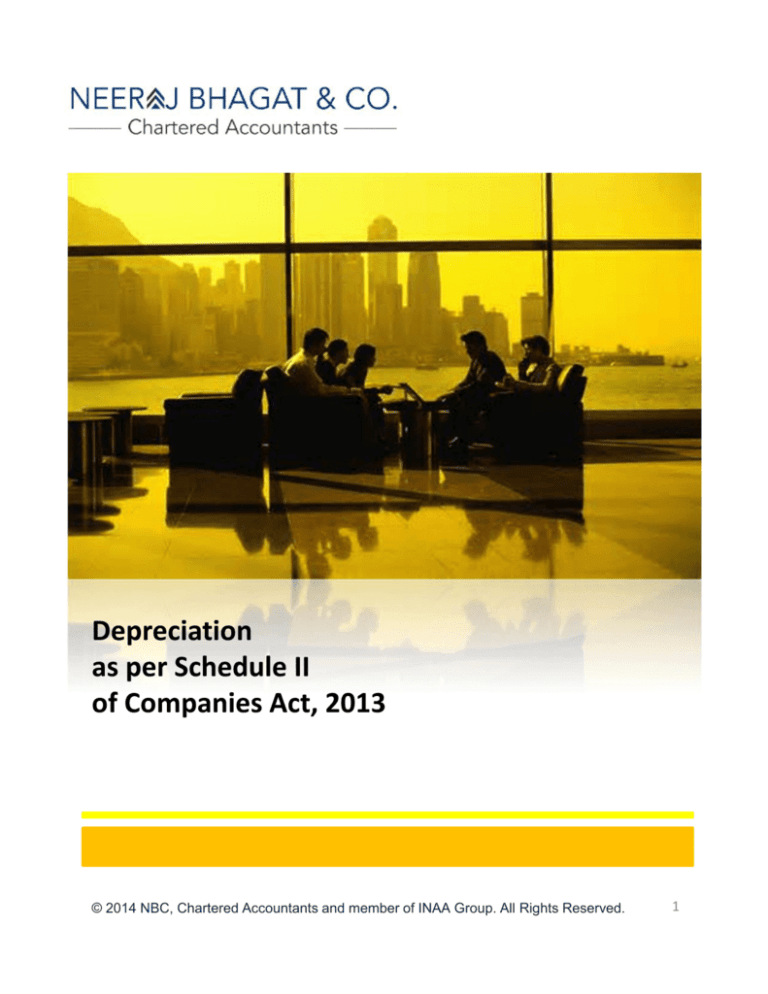
Depreciation
as per Schedule II
of Companies Act, 2013
© 2014 NBC, Chartered Accountants and member of INAA Group. All Rights Reserved.
1
Contents
•
FAQs
•
What is Schedule II
•
Applicability of Schedule II
•
Carrying Cost of Asset
•
Comparison with Schedule XIV
•
Component Accounting
•
Minimum cost of asset
•
Pro-rata depreciation
•
Extra-shift depreciation
•
Residual Value
•
Intangible Assets
•
Disclosure in FS
•
Our Offices
www.neerajbhagat.com
2
FAQs
Q1. When are the new provisions of depreciation applicable from?
A. New provisions of 2013 Act are made applicable w.e.f. 1st April,
2014.
Q2. Should one wait for next financial year or comply now?
A. Yes, the provisions should be complied right from April, 2014
mandatorily as the carrying cost is to be depreciated in remaining
useful life of an asset as per Schedule II, and where remaining
useful life is Nil, carrying cost (after retaining residual value) is to
be recognized in opening balance of retained earnings.
Q3. What can be the Estimated Residual Value of an asset?
A. Residual value should generally be not more than 5% of the
original cost of the asset for all companies (other than Regulatory
Authority constituted under an Act of Parliament or by Central
Government). However, it can be higher in case of all other
companies, if justification is disclosed in financial statements.
Q4. What is the useful life of the assets to be taken?
A. Useful life of assets have been prescribed under Part C of
Schedule II (for other than Regulatory Authority). The useful life
shall not be more than as prescribed in Part C . In case it is more
than that prescribed in Part C of schedule II then justification for
the same needs to be given in financial statement.
www.neerajbhagat.com
3
Q5. What if useful life of a part of asset is significant and
different from useful life of the remaining asset?
A. In that case, useful life of the significant part shall be
determined separately.
For instance, Asset X has 3 components- Part A, B and C
which have different costs and useful lives. Depreciation
would be considered separately for such parts as per Schedule
II.
Asset X
Part
A
Asset X
• Useful life 20
years
• Cost INR
10,000
Part
B
Part
C
Depreciation =
10 ,000/ 20 =
500 p.a
• Useful life 1
year
• Cost INR
3,000
• Useful life 5
years
• Cost INR
1,000
Depreciation =
3,000/ 1 =
3,000 p.a
Depreciation =
1,000/ 5 = 200
p.a
www.neerajbhagat.com
4
•
What is Schedule II ?
Schedule II of Companies Act 2013 provides the useful lifes of tangible
assets as against the minimum rates of depreciation which were specified
in Schedule XIV of the Companies Act, 1956.
Here are some of the assets as mentioned in Part C of Schedule II:
Nature of Assets
Useful Life (years)
Plant and Machinery
15
Furniture and Fittings
10
Motor Vehicle
10
Computers & Laptops
3
Office Equipment
5
Buildings
60
www.neerajbhagat.com
5
• Applicability of Schedule II
Schedule
II- Part C
Applicability
in case of
Regulated
Entities
No
Notified useful
life and residual
value shall
apply
Intangible
Assets
Other
Companies
No
Yes
Provisions of
accounting
standards shall
apply*
Can useful life and residual
value be different?
Yes, if justified in
financial statements
*Except for “Toll Roads” created under ‘Build, Operate and Transfer’, ‘Build, Own, Operate
and Transfer’ or any other form of public private partnership route in case of road projects,
amortization basis will be same as what was applicable under the Companies Act, 1956.
www.neerajbhagat.com
6
Schedule II is applicable to all companies, except in case of:
1. Regulatory Authority constituted under an Act of Parliament or by
Central Government – for which notified rates are applicable .
2. Intangible Assets, for which notified Accounting Standards apply.
• Other companies (viz. other than those mentioned above), useful
life and residual value shall not be more than that specified in Part C.
However, the Ministry of Corporate Affairs had later issued
amendment vide notification F No. 17/60/2012-CL-V where it has
been provided that “the useful life of an asset shall not be longer
than the useful life specified in Part ‘C’ and the residual value of an
asset shall not be more than five per cent of the original cost of the
asset.
*Provided that in case useful life or residual value of the asset is
different from the above limits, justification for the difference shall be
disclosed in its financial statement.”
Thus, now all companies (other than the entities in respect of which a
Regulatory Authority has specified the useful life or residual value)will have to
take the useful life and residual value as per Part C of schedule II . In case it
differs from what is stated in Schedule II, they will have to give reasons
justifying the same. By virtue of this, a level playing field has been provided to
the Indian Companies vis- a -vis the international practices in this regard.
www.neerajbhagat.com
7
• Carrying Cost of Asset as on 1st April 2014
From the date Schedule II comes into effect, the carrying amount
of the asset as on that date (i.e., 1st April, 2014):
•should be depreciated over the remaining useful life of the asset
as per Schedule II;
•after retaining the residual value, should be recognized in the
opening balance of retained earnings where the remaining useful
life of an asset is nil.
Illustration:
A company acquired a building (other than factory building and RCC Frame
Structure) at a cost of INR 100 million. The company was depreciating the
building according to Schedule XIV at SLM rate, i.e., 1.63% (rate computed
assuming useful life to be approximately 60 years). Now, in April, 2014,
Schedule II of the Companies Act, 2013 became effective, useful life specified
in which is 30 years.
Analysis
A. Transition effect in case the building is acquired on 1st April, 2000
Depreciation charged till FY 2013-14, i.e., depreciation on SLM for 14 years
= INR 100 mn*1.63%*14 yrs = INR 2,28,20,000
Carrying Value as on 1st April, 2014
Cost less accumulated depreciation till FY 2013-14
=INR 10,00,00,000 – INR 2,28,20,000
=INR 7,71,80,000
The carrying value as on 1st April, 2014 will be depreciated over the remaining
useful life of the asset as per Schedule II of the Companies Act, 2013. The
remaining useful life as per new Schedule is (30-14) 16 years. Accordingly,
depreciable amount of INR 7,71,80,000 will be depreciated over 16 years.
www.neerajbhagat.com
8
So, annual depreciation to be charged to Profit and loss account from FY 201415 onwards would be INR 7,71,80,000/16 yrs , i.e., INR 48,23,750.
Impact
•After 16 years from FY 2014-15, i.e., from FY 2030-31 onwards no depreciation
would be charged.
•For 16 years, i.e., from FY 2014-15 to FY 2029-30, higher depreciation would
be charged. If Schedule II would not have been introduced, depreciation
charged annually would have been INR 100 mn * 1.63% = INR 16,30,000. After
the introduction of Schedule II of the Companies Act, 2013, depreciation
charged for these 16 years would be INR 48,23,750 which is higher by INR
31,93,750 per year.
B. Transition effect in case the building is acquired on 1st April, 1980
If the building would have been purchased on 1st April, 1980, then as on 1st
April, 2014, useful life of 30 years as per new Schedule has already expired. In
such case, the carrying value as on 1st April, 2014 would be recognized in the
opening balance of retained earnings.
Depreciation charged till FY 2013-14, i.e., depreciation on SLM for 34 years
= INR 100 mn*1.63%*34 yrs = INR 5,54,20,000
Carrying Value as on 1st April, 2014
Cost less accumulated depreciation till FY 2013-14
= INR 10,00,00,000 – INR 5,54,20,000 = INR 4,45,80,000
Carrying value as on 1st April, 2014 of INR 4,45,80,000 would be recognized in
the opening balance of retained earnings. (assuming residual value to be nil)
Impact
•Opening balance of retained earnings would reduce by the carrying amount.
•No depreciation from FY 2014-15 onwards shall be charged to the profit and
loss account, which otherwise would have been charged if Schedule II would
not have come into force.
Note: In case, there is a residual value, say, INR 10,00,000 then INR 4,35,80,000
would be recognized in the opening balance of retained earnings and INR
10,00,000 will remain in the carrying amount of asset.
www.neerajbhagat.com
9
• Comparison with Schedule XIV of Companies Act, 1956
Companies
other than
regulatory
authority
Useful
Life
Residual
Value
Companies
Act, 2013
Companies
Act, 1956
Can be
higher
Yes
No
Can be
lower
Yes
Yes
Can be
higher
Yes
*No
provision
Can be
lower
Yes
*No
provision
*Residual value was inbuilt in depreciation rates prescribed under
Schedule XIV.
www.neerajbhagat.com
10
•
Component Accounting
Useful life specified in Part C of the Schedule is for whole of the
asset.
Where cost of a part of the asset is significant to total cost of
the asset and useful life of that part is different from the useful
life of the remaining asset, useful life of that significant part
should be determined separately.
Hence, component accounting is mandatory pursuant to the
introduction of Companies Act, 2013.
Asset X
Part
A
Asset X
• Useful life 20
years
• Cost INR
10,000
Part
B
Part
C
Depreciation =
10,000 / 20 =
500 p.a
• Useful life 1
year
• Cost INR
3,000
• Useful life 5
years
• Cost INR
1,000
Depreciation =
3,000/ 1 =
3,000 p.a
Depreciation =
1,000/ 5 = 200
p.a
www.neerajbhagat.com
11
No concept of minimum cost of asset
There is no specific requirement of 100% depreciation on
assets whose actual cost does not exceed Rs. 5,000 in the
Companies Act, 2013.
Pro-rata basis of charging depreciation
Where, during any financial year, addition/ deletion has been
made to any asset, depreciation shall be calculated on pro
rata basis from/ up-to the date of such addition/ deletion
respectively.
Extra Shift Depreciation
No separate rates have been prescribed for extra shift
depreciation. The period of time an asset is used in extra shift,
depreciation will increase by 50% in case of double shift
working and by 100% in case of triple shift working.
www.neerajbhagat.com
12
Residual Value
Depreciable amount is the cost of an asset, or other amount
substituted for cost, less its residual value. Ordinarily, the
residual value is often insignificant, but it should generally be not
more than 5% of the original cost of the asset.
Intangible Assets
No separate depreciation rate is prescribed for intangible assets
in the Schedule II of the Companies Act, 2013. Rather, the same
will be governed by the notified AS (i.e., AS 26).
In case of intangible assets (Toll Roads) created under ‘Build,
Operate and Transfer’, ‘Build, Own, Operate and Transfer’ or any
other form of public private partnership route in case of road
projects, amortization basis will be same as what was applicable
under
the
Companies
Act,
1956.
In practice, we do not expect a change in amortization amount in
respect of Intangible assets pursuant to applicability of
Companies Act,2013.
Disclosure in Financial Statements
The following information shall also be disclosed in the accounts,
namely:
(i) Depreciation method used, and
(ii) The useful lives of the assets for computing depreciation, if
they are different from the life specified in the Schedule.
www.neerajbhagat.com
13
Our Offices
New Delhi:
S-13, St. Soldier Tower,
G-Block Commercial Complex,
Vikas Puri , New Delhi - 110018, India
Phone
Fax
:
:
:
:
+ 91 11 28543739
+91 11 28544939
+91 11 45527239
+91 11 43850030
Gurgaon:
1156, Tower B2, 11th Floor, Spaze
I Tech Park, Sohna Road,
Sector 49, Gurgaon-122001
Phone
Fax
: +91 124 4371317
+ 91 124 4371318
: +91 11 43850030
Neeraj Bhagat & Co.
About NBC
NBC is a team of
distinguished chartered
accountant, corporate
financial advisors and tax
consultants in India. Our
firm of chartered
accountants represents a
coalition of specialized skills
that is geared to offer
sound financial
solutions and advices. The
organization is a
congregation of
professionally qualified and
experienced persons who
are committed to add value
and optimize the benefits
accruing to clients.
Mumbai:
Unit No.3, 1st Floor, New
Laxmi Shopping Centre, A-Wing,
H.D.Road, Ghatkopar (W),
Mumbai – 400086 (India)
Tel
: + 91 98202-63544
+ 91 22-65957459
E-mail : info@neerajbhagat.com
Web site : www.neerajbhagat.com
14

